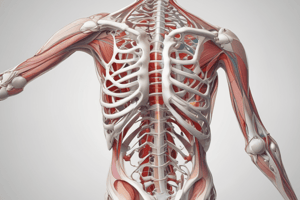Podcast
Questions and Answers
What are the three main components of the musculoskeletal system?
What are the three main components of the musculoskeletal system?
Muscles, bones, and joints
What is muscle tone, and how is it described?
What is muscle tone, and how is it described?
Muscle tone is the resistance of a muscle to passive stretching, describing its stiffness or elasticity.
What is the difference between intention tremor and resting tremor?
What is the difference between intention tremor and resting tremor?
Intention tremor is more apparent during voluntary movement, while resting tremor is more apparent when the client is relaxed and diminishes with activity.
What is fasciculation, and what does it appear as?
What is fasciculation, and what does it appear as?
What is crepitation, and how is it assessed?
What is crepitation, and how is it assessed?
What is the range of motion, and how is it assessed?
What is the range of motion, and how is it assessed?
What is atrophy, and what is hypertrophy?
What is atrophy, and what is hypertrophy?
What is the grading scale for muscle strength, and what does a score of 3 indicate?
What is the grading scale for muscle strength, and what does a score of 3 indicate?
What is the difference between active movement against gravity only and active movement against gravity and some resistance?
What is the difference between active movement against gravity only and active movement against gravity and some resistance?
What is the significance of observing a patient's gait during inspection?
What is the significance of observing a patient's gait during inspection?
What is the purpose of palpation in assessing muscle tone and function?
What is the purpose of palpation in assessing muscle tone and function?
What is the significance of crepitus in assessing joint function?
What is the significance of crepitus in assessing joint function?
What is the purpose of using a goniometer in physical examination?
What is the purpose of using a goniometer in physical examination?
What is footdrop, and what is its significance in physical examination?
What is footdrop, and what is its significance in physical examination?
What is muscle atrophy, and what are its causes?
What is muscle atrophy, and what are its causes?
What is scoliosis, and what are its characteristic findings?
What is scoliosis, and what are its characteristic findings?
Flashcards are hidden until you start studying
Study Notes
Musculoskeletal System Assessment
- The musculoskeletal system includes muscles, bones, and joints.
- Muscles are assessed on strength, tone, size/mass, symmetry, tremors, and pain.
Muscles
- Muscle tone describes muscular resistance to passive stretching.
- Muscle size/mass is measured circumferentially on the largest area of the muscle.
- Muscle symmetry is compared on both sides of the body.
- Tremors are involuntary trembling of a limb or body part, and can be of two types:
- Intention tremor: more apparent when attempting a voluntary movement.
- Resting tremor: more apparent when the client is relaxed and diminishes with activity.
- Fasciculation is an abnormal contraction of a bundle of muscle fibers that appears as a twitch.
Joints
- Joints are assessed on tenderness, swelling, thickening, pain, crepitation, and range of motion.
- Crepitation is a crackling, grating sound.
Bones
- Bones are assessed on normal form.
Muscle Strength Grading (Scale 0-5)
- 0: No detection of muscular contraction.
- 1: Barely detectable flicker or trace of contraction.
- 2: Active movement of body part with elimination of gravity.
- 3: Active movement against gravity only and not against resistance.
- 4: Active movement against gravity and some resistance.
- 5: Active movement against full resistance without evident fatigue (normal muscle strength).
Inspection
- Body structure is assessed for proper posture and body alignment.
- Misaligned spine, curvature of the spine, and unusual gait are abnormal findings.
- Involuntary movements, tremors, and tics are also assessed.
Palpation
- Temperature, tenderness, swelling, enlargement, and crepitus are assessed.
- Muscle tone is evaluated for consistency and symmetry.
- Range of motion and pain are also assessed.
Special Tests
- Goniometer measures the angle of the joint.
- Abnormal findings include:
- Footdrop: plantar flexion of the foot with the toes bent toward the instep.
- Muscle spasms or cramps: strong, painful contractions.
- Muscle weakness: can result from malfunction in the central or peripheral nervous system, or within the muscle itself.
- Muscle atrophy: muscle wasting due to denervation, disuse, aging, or nutritional deficiency.
Spinal Abnormalities
- Scoliosis: lateral deviation of the spine, with uneven shoulder blade height, unequal distance between the arms and the body, and asymmetrical waistline.
- Kyphosis: abnormal curvature of the thoracic spine.
- Lordosis: abnormal curvature of the lumbar spine.
Studying That Suits You
Use AI to generate personalized quizzes and flashcards to suit your learning preferences.





